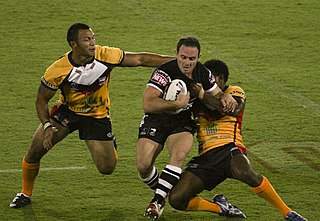
Rugby league football, commonly known as rugby league in English-speaking countries and rugby XIII in non-Anglophone Europe and South America, and referred to colloquially as rugby, football, footy or league in its heartlands, is a full-contact sport played by two teams of thirteen players on a rectangular field measuring 68 m (74 yd) wide and 112–122 m (122–133 yd) long with H-shaped posts at both ends. It is one of the two major codes of rugby football, the other being rugby union. It originated in 1895 in Huddersfield, Yorkshire, England, as the result of a split from the Rugby Football Union (RFU) over the issue of payments to players. The rules of the game governed by the new Northern Rugby Football Union progressively changed from those of the RFU with the specific aim of producing a faster and more entertaining game to appeal to spectators, on whose income the new organisation and its members depended.

In the game of rugby union, there are 15 players on each team, comprising eight forwards and seven backs. In addition, there may be up to eight replacement players "on the bench", numbered 16–23. Players are not restricted to a single position, although they generally specialise in just one or two that suit their skills and body types. Players that play multiple positions are called "utility players".
In certain sports, such as football, field hockey, ice hockey, handball, rugby union, lacrosse and rugby league, winger is a position. It refers to positions on the extreme left and right sides of the pitch, or playing field. In American football and Canadian football, the analogous position is the wide receiver. Wingers often try to use pace to exploit extra space available on the flanks that can be made available by their teammates dominating the centre ground. They must be wary however of not crossing the touchline, or sidelines, and going out of play. In sports where the main method of scoring involves attacking a small goal in the centre of the field, a common tactic is to cross the ball to a central teammate.
A rugby league team consists of 13 players on the field, with 4 substitutes on the bench. Each of the 13 players is assigned a position, normally with a standardised number, which reflects their role in attack and defence, although players can take up any position at any time.
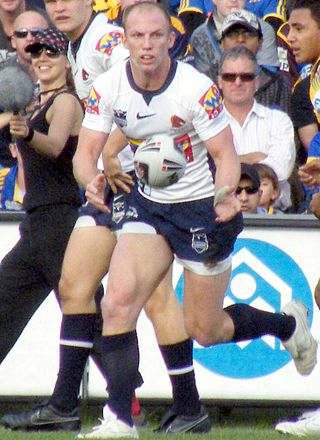
Darren James Lockyer is an Australian television commentator and former professional rugby league footballer. Lockyer was an Australian international and Queensland State representative captain, who played his entire professional career with the Brisbane Broncos.

Touch rugby refers to games derived from rugby football in which players do not tackle each other but instead touch their opponents using their hands on any part of the body, clothing, or the ball.

In sports, a starting lineup is an official list of the set of players who will participate in the event when the game begins. The players in the starting lineup are commonly referred to as starters, whereas the others are substitutes or bench players.
A bomb, also known as an up and under or a Garryowen, is a type of kick used in various codes of football. As the names suggests, it is a high kick intended to send the ball relatively straight up so players can get under it before it comes down.
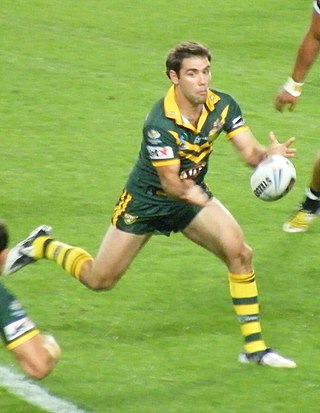
Like most forms of modern football, rugby league football is played outdoors on a rectangular grass field with goals at each end that are attacked and defended by two opposing teams. The rules of rugby league have changed significantly over the decades since rugby football split into the league and union codes. This article details the modern form of the game and how it is generally played today, although rules do vary slightly between specific competitions.
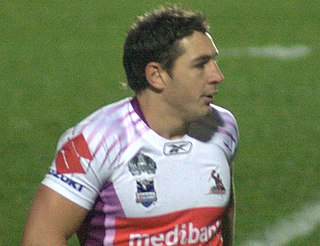
William Slater is an Australian former professional rugby league footballer who played in the 2000s and 2010s. Slater is the current coach of the Queensland Maroons, whom he coached to victories in the 2022 and 2023 State of Origin series.
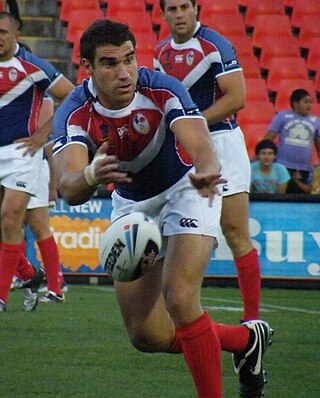
Five-eighth or Stand-off is one of the positions in a rugby league football team. Wearing jersey number 6, this player is one of the two half backs in a team, partnering the scrum-half. Sometimes known as the pivot or second receiver, in a traditional attacking 'back-line' play, the five-eighth would receive the ball from the scrum half, who is the first receiver of the ball from the dummy-half or hooker following a tackle.

Karmichael Neil Matthew Hunt is a New Zealand professional rugby league coach and former player who is the current head coach of the Souths Logan Magpies in the Queensland Cup, as well as the Cook Islands national rugby league team.

Clive Bernard Churchill AM was an Australian professional rugby league footballer and coach in the mid-20th century. An Australian international and New South Wales and Queensland interstate representative fullback, he played the majority of his club football with and later coached the South Sydney Rabbitohs. He won five premierships with the club as a player and three more as coach. Retiring as the most capped Australian Kangaroos player ever, Churchill is thus considered one of the game's greatest ever players and the prestigious Clive Churchill Medal for man-of-the-match in the NRL grand final bears his name. Churchill's attacking flair as a player is credited with having changed the role of the fullback.

The place kick is a type of kicking play commonly used in American football, association football (soccer), Canadian football, rugby league, and rugby union. It was historically used in Australian rules football, but it was phased out of the game more than 100 years ago.
Rugby league football has accrued considerable jargon to describe aspects of the game. Many terms originate in the Laws of the Game. Some aspects of the game have more than one term referring to them. Different terms have become popularly used to describe an aspect of the game in different places, with notable differences between the Northern and Southern Hemispheres.

The 2009 NRL Grand Final was the conclusive and premiership-deciding game of the NRL's 2009 Telstra Premiership season. Played on 4 October 2009 at Sydney's ANZ Stadium was contested between the Parramatta Eels and the Melbourne Storm, the latter competing in their 4th grand final in a row. That was later stripped from them for breaking the salary cap rule. It was also the first Grand Final to feature the two referee system, with Shayne Hayne and Tony Archer being the first referees to jointly officiate in an NRL Grand Final.
In rugby league football, the Laws of the Game are the rules governing how the sport is played. The Laws are the responsibility of the Rugby League International Federation, and cover the play, officiating, equipment and procedures of the game.
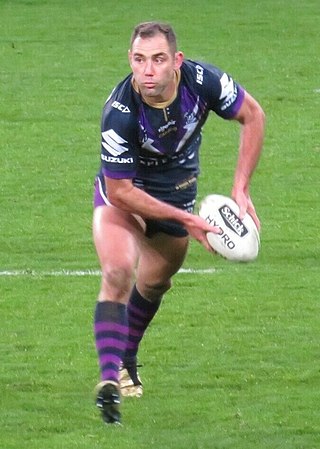
Hooker is one of the positions in a rugby league football team. Usually wearing jersey or shirt number 9, the hooker is one of the team's forwards. During scrums the hooker plays in the front row, and the position's name comes from their role of 'hooking' or 'raking' the ball back with the foot. For this reason the hooker is sometimes referred to in Australia as the rake. Hookers have a great deal of contact with the ball, as they usually play the role of acting halfback or dummy half, picking the ball up from the play-the-ball that follows a tackle. Hookers therefore have much responsibility in that they then decide what to do with the ball, whether that be to pass it, run with it, or occasionally to kick it. Therefore, together with the two halves and fullback, hooker is one of the four key positions that make up what is sometimes called a team's 'spine'. A trend of halves converting into hookers followed the introduction of the 10 metre rule, and many players have switched between these positions in their careers such as Geoff Toovey, Andrew Johns, Craig Gower and Peter Wallace.
The 2011 Queensland Cup season was the 16th season of Queensland's top-level statewide rugby league competition run by the Queensland Rugby League. The competition, known as the Intrust Super Cup due to sponsorship from Intrust Super, featured 12 teams playing a 25-week-long season from March to September.

Anthony Milford is an Australian Samoan international rugby league footballer who plays as a five-eighth and halfback for the Dolphins in the National Rugby League (NRL).














